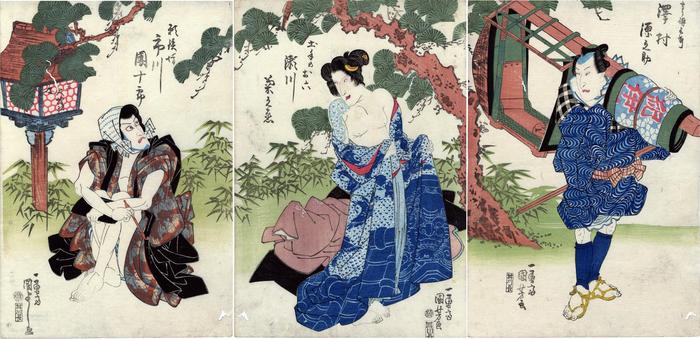Utagawa Kuniyoshi (歌川国芳) (artist 11/15/1797 – 03/05/1861)
Triptych of Ichikawa Danjurō VII (市川団十郎) as Gantetsubō (願鉄坊) on the left, Segawa Kikunojō V (瀬川菊之丞) as Dote no Oroku (土手のお六) in the middle and Sawamura Gennosuke II (沢村源之助) as Denbei (伝兵衛) on the right
1831
30 in x 14.5 in (Overall dimensions) color woodblock print
Signed: Ichiyūsai Kuniyoshi ga
一勇斎国芳画 on the middle and right panels
一勇斎国よし画 on the left
Publisher: Kawaguchiya Chōzō
(Marks 230 - seal 21-202)
Censor's seal: kiwame - on center and left panels only
Waseda University - left panel
Waseda University - middle panel
Waseda University - right panel
Museum of Fine Arts, Boston - 1856 Toyokuni III print of Date no Oroku and Gantetsubō
Victoria and Albert Museum Dote no Oroku, "...literally Oroku of the Embankment", is an akuba or "An evil middle-aged woman in sewamono drama, who indulges in extortion, blackmail or murder. She is usually a clever person, who can bluff, fight and swindle. She is also often possessed with a certain sense of loyal chivalry."
At one point Dote no Oroku worked as a snake charmer, a hebi-zukai (蛇遣い), in the Mukō Ryōgoku (向両国), an entertainment district in Edo. She was married to Omamori Denbei.
Gantetsu is a scoundrel who pretends to be a devout Buddhist, a shūgyōsha (修行者), but will do anything for money.
The source of this information is Kabuki21.
The bō (坊) of Gantetsubō means 'monk' or 'bonze'.
****
This triptych commemorates a possible performance of a play called Iro misao kuruwa bunsho (色操廓文章) in the seventh month of 1831 at the Kawarazaki-za in Edo.
The relatively good condition and strong coloring allow us to enjoy some of the subtler elements of this triptych - especially in the center and left panels. In the center, the bare-chested female figure has lowered her robes. While this was an exceptional act in a kabuki play - considering that only men were allowed to play women - it is her elaborate, even gorgeous, blue dyed garment which eventually captures our attention. The bottom part represents a beautifully tiled rooftop with a giant lion's head capping its outermost corner. In the speckled sky above are several small birds flittering about.
In the panel to the left is a seated figure with an equally remarkable robe decorated with gray bats flying on a rust colored ground. Something easily missed. Use the zooming tool to get a full appreciation of these designs.
Another interesting feature of this triptych is the figure on the right. He is shouldering a kago or palanquin. There are lots of examples of kago sitting on the ground with either a customer sitting there or standing nearby, but this is the only example of one that has been 'collapsed' so it can be carried by one porter, instead of two. Very curious and therefore very instructive.
****
A most unusual triptych, showing a kabuki scene with a woman pulling down her kimono to reveal a tattooed shoulder and her bare breasts. 'Female' nudity of this kind is most unusual in Kabuki Ukiyo-e. Also Kuniyoshi's signature in the left panel is written in the 'Osaka' style.
Ex B. W. Robinson collection
****
There is another copy of the left-hand panel in the collection of Doisha University.
****
The Kuniyoshi Project noted the unusual nature of the signature on the left-hand panel. For the character for 'yoshi' the artist chose to use the hiragana rather than his general use of the kanji.
actor prints (yakusha-e - 役者絵) (genre)
Kawaguchiya Chōzō (川口屋長蔵) (publisher)
Ichikawa Danjūrō VII (七代目市川團十郎: 11/1800 to 2/1832) (actor)
Segawa Kikunojō V (五代目瀬川菊之丞: 11/1815 to 1/7/1832) (actor)
Sawamura Gennosuke II (二代目沢村源之助: from 11/1817 to 10/1831) (actor)
Tattoo (genre)
bats (komori - 蝙蝠) (genre)
